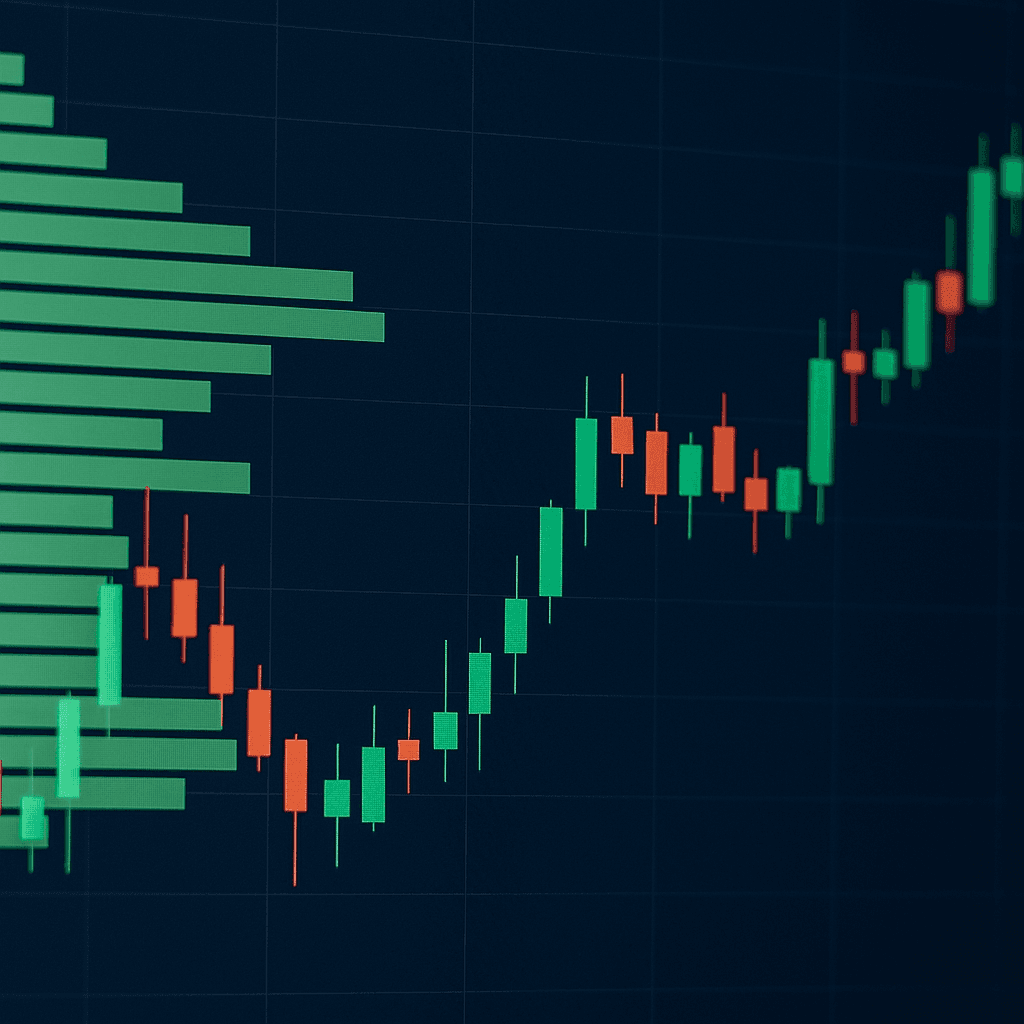
Table of Contents
Volume Profile isn’t just another indicator it’s the X-ray vision of price action. While most traders obsess over candlesticks and moving averages, Volume Profile reveals the why behind price movement: where the real battles between buyers and sellers take place. If you trade breakouts, reversals, or trend continuations, understanding Volume Profile can give you a serious edge.
What Is Volume Profile?
Volume Profile is a volume-by-price indicator that shows how much trading occurred at each price level over a specific time period. Unlike traditional volume bars (which show volume over time), Volume Profile stacks volume horizontally along the price axis.
Key components:
- Point of Control (POC): The price level with the highest traded volume.
- Value Area (VA): The price range where 70% of volume occurred (typically split into Value Area High and Low).
- High Volume Nodes (HVN): Price levels with heavy trading—often act as magnets or consolidation zones.
- Low Volume Nodes (LVN): Thinly traded areas—price often moves quickly through these.
Why Volume Profile Matters for Traders
Volume Profile helps you:
- Identify true support and resistance based on actual market participation.
- Avoid false breakouts by seeing whether price is breaking out of a high-volume zone or into a low-volume void.
- Time entries and exits with more precision by aligning with institutional footprints.
Think of it as a market structure heatmap—it shows where traders care and where they don’t.
How to Read Volume Profile Like a Pro
Let’s break it down with a simple framework:
1. Balance vs. Imbalance
- Balanced Profile: Bell-shaped, centered around the POC. Market is in equilibrium—expect range-bound behavior.
- Imbalanced Profile: Skewed or double-distribution. Market is trending or transitioning—look for breakouts or reversals.
2. POC Shifts
- A rising POC signals accumulation and bullish bias.
- A falling POC suggests distribution and bearish pressure.
3. Volume Gaps (LVNs)
- Price often rips through LVNs due to lack of interest—ideal for breakout entries or stop runs.

Volume Profile Trading Strategies
Strategy 1: Breakout Confirmation with Volume Profile
Setup:
- Price consolidates near the top of a value area.
- Watch for breakout above Value Area High (VAH) with volume.
- Confirm with price moving into a low-volume zone (LVN)—expect fast movement.
Entry: On breakout candle close above VAH with rising volume.
Stop: Below POC or Value Area Low (VAL).
Target: Next HVN or psychological level.

Strategy 2: Fade the Extremes
Setup:
- Price spikes outside the value area but fails to hold.
- Look for rejection wicks or reversal candles.
Entry: On re-entry into the value area.
Stop: Just outside the failed breakout level.
Target: POC or opposite edge of the value area.
Strategy 3: Trend Continuation via POC Shift
Setup:
- Price breaks out and consolidates.
- New POC forms higher (bullish) or lower (bearish).
Entry: On pullback to the new POC.
Stop: Below recent swing low (bullish) or high (bearish).
Target: Measured move or next HVN.

Real-World Example: $NVDA Breakout with Volume Profile
In early 2024, $NVDA consolidated between $400–$420. Volume Profile showed a strong POC at $410 and a low-volume gap between $420–$440.
When price broke $420 with volume, it sliced through the LVN and hit $440 in two sessions—a textbook volume gap breakout.
Tools to Use Volume Profile
You can access Volume Profile on platforms like:
- TradingView: Built-in Volume Profile tools (Fixed Range, Session, Visible Range).
- Thinkorswim: “Monkey Bars” and Volume Profile studies.
- Sierra Chart / NinjaTrader: Advanced customization for futures traders.
Volume Profile vs. Market Profile
While both analyze volume distribution:
- Volume Profile is plotted by price.
- Market Profile is plotted by time and uses TPOs (Time Price Opportunities).
Volume Profile is more intuitive for breakout and momentum traders, while Market Profile is favored by auction theory purists.
Common Mistakes to Avoid
- Ignoring context: Volume Profile is powerful, but only when combined with trend, news, and broader market structure.
- Overtrading LVNs: Not every low-volume area is a breakout opportunity—wait for confirmation.
- Forcing trades at the POC: It’s a magnet, not a trampoline. Let price show intent.
Final Thoughts: Trade Where the Volume Is
Volume Profile doesn’t predict the future—it reveals where the market has already voted. That’s your edge. Whether you’re day trading breakouts or swing trading reversals, this tool helps you trade with the institutions, not against them.
Start by adding Volume Profile to your charts. Watch how price reacts at the POC, VAH, and LVNs. Then build your playbook.
Sources:
Legal Disclaimer
This article is for educational purposes only and does not constitute financial advice or a recommendation to buy or sell any specific securities. Always consult with a licensed financial advisor before making investment decisions. This post may include affiliate links. If you click and purchase, I may receive a small commission at no additional cost to you.

About Daniel M.
Founder of Nice Breakout
founder of Nice Breakout is a seasoned professional with over 5 years of dedicated experience navigating the intricacies of financial markets, particularly utilizing the Thinkorswim platform. His passion lies in empowering traders and investors by providing insightful analysis and cutting-edge tools.


